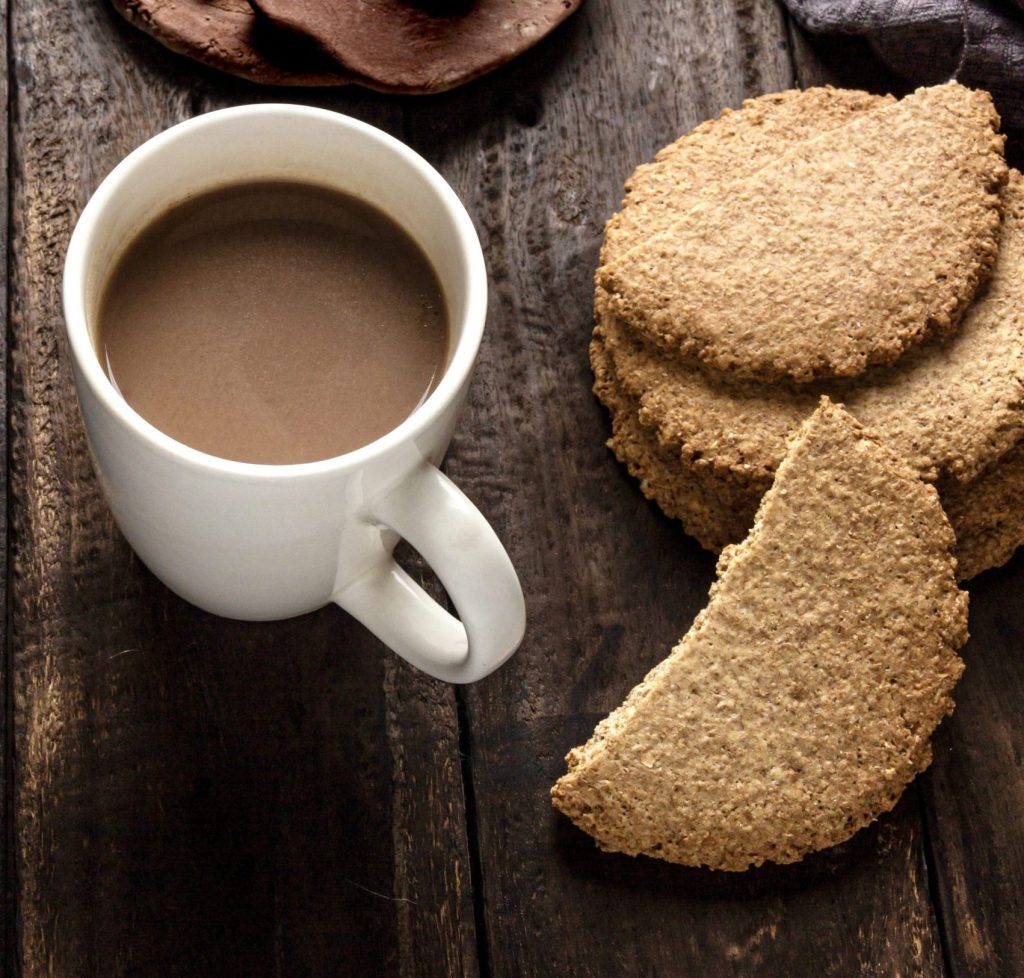This post is also available in: Español
This is an easy recipe for guatemalan higos secos or higos cristalizados (dry sugared figs or crystalized figs) from Guatemala.This Guatemalan traditional candy is also referred to as maleta de higos (figs in a suitcase) because the sugared figs are usually served together in groups of four or five figs.
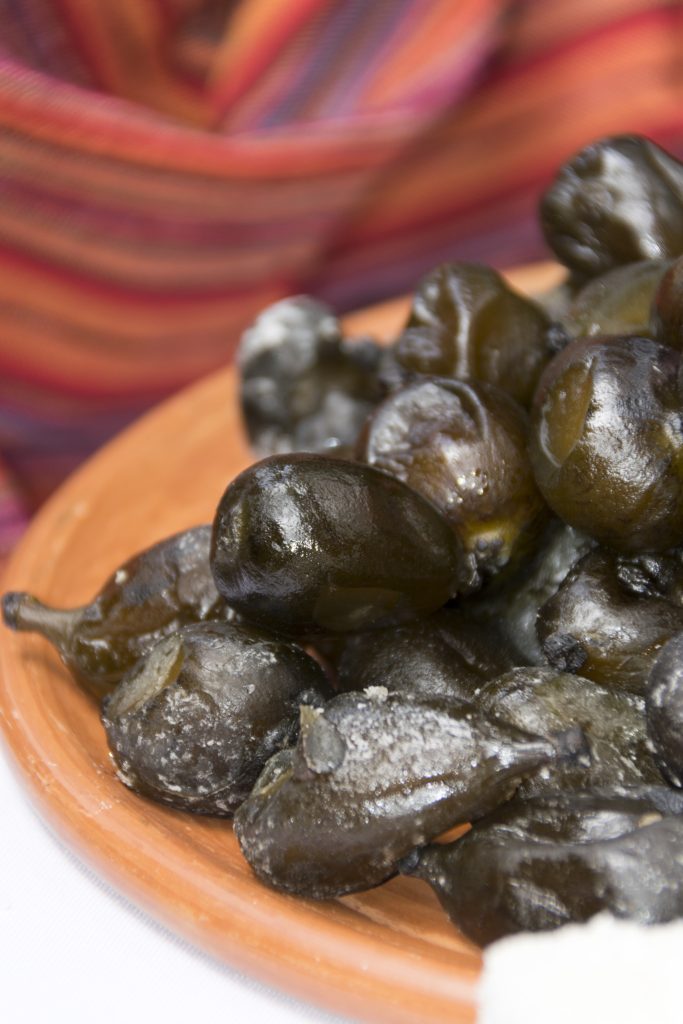
Growing up in Guatemala, I was always fascinated by the huge variety of traditional Guatemalan candy, each with its own unique flavor and story. Among these, the recipe for maletas de higos (candied figs) is one of my favorites and also an easy Guatemalan candy recipe to make at home.
I loved eating these sweet candied figs for dessert or as a snack after school, accompanied by a tall glass of horchata or rosa de Jamaica.
The history of Guatemalan traditional candy
Making artisanal candy is a very important part of Guatemalan culinary culture. There are literally hundreds of different traditional Guatemalan candy from the melt in your mouth canillitas de leche and the delicious bolitas de naranja (orange balls) or bolitas de tamarindo (tamarind balls) to candy using local fruit like chilacayotes and colochos de guayaba (guava).
The history of traditional Guatemalan candy is a fascinating blend of cultures and flavors, where the Spanish passion for sugary treats met the rich variety of native fruits. This fusion began in the Colonial era, around 1524, when the Spanish brought with them not only their recipes but also the influences of nearly eight centuries of Arab presence in Spain.
It’s no coincidence that La Antigua Guatemala, formerly known as Santiago de Guatemala, emerged as a center for artisanal confectionery. The art of making sweets there, deeply infused with cultural and historical significance, spread across the country, from the capital city to places like Quetzaltenango and Cobán.
Among these traditional sweets, crystallized figs, or maleta de higos, hold a special place, representing a delicious link to Guatemala’s past.
Crystalized figs: artisanal Guatemalan candy
Figs, originally from the Mediterranean, were introduced to Guatemala by the Spanish, who also started the local production of sugar cane, providing a key ingredient for candy making. The Guatemalan confectionery scene, rooted almost entirely in colonial traditions due to the indigenous people’s unfamiliarity with sugar, thrived. The creation of crystallized figs or maleta de higos showcases a creative use of this new ingredient combined with local fruits, leading to sweets that are both a delight to the palate and a reflection of Guatemala’s complex cultural tapestry. Candied figs made through the nixtamalization process, exemplify the intricate blend of history, tradition, and flavors that define Guatemalan artisanal candy.
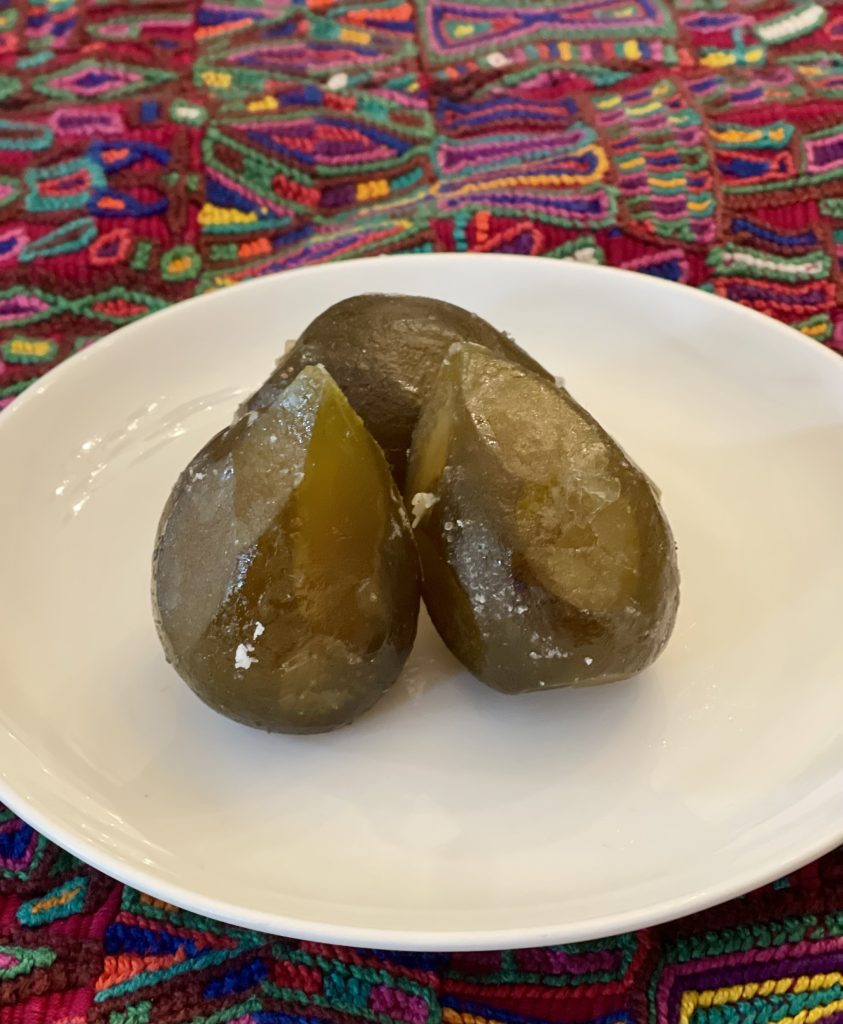
What are maleta de higos or dry sugared figs
This Guatemalan traditional candy, different from the syrup-soaked higos en miel or dulce de higos dessert, is one of my favorite Guatemalan candy.. My childhood memories are filled with visits to Doña Maria Gordillo’s traditional candy store in Antigua Guatemala, a place where the aroma of sweet treats filled the air. It was there that I first fell in love with maleta de higos.
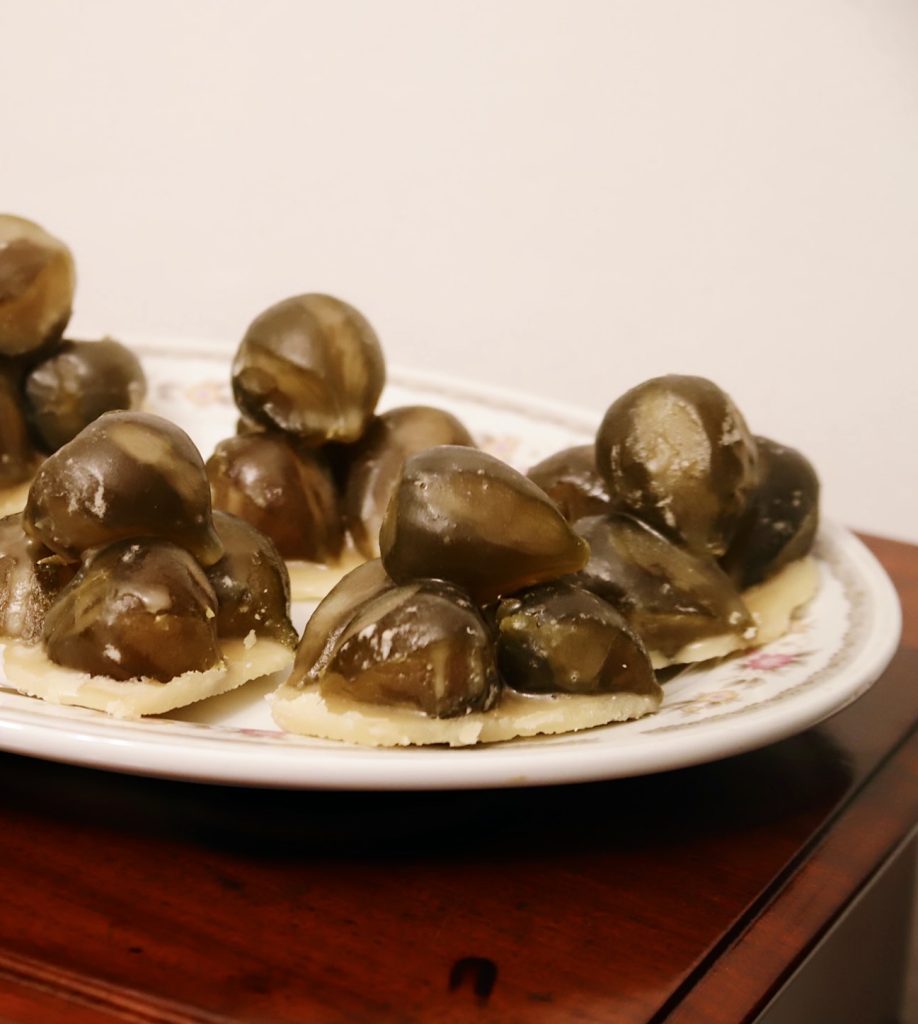
The way these figs are prepared sets them apart from other Guatemalan traditional sweets. Unlike the soft, syrupy texture of higos en miel (figs in syrup) , maletas de higos are sweet crystallized or dry fig candy, offering a delightful firm texture on the outside while soft and sweet on the inside. Their texture is achieved by using the ancient method of nixtamalization, a method traditionally used in grains like corn but also used to make crystalised fruit candy including figs, chilacayotes and other guatemalan candy. It’s this unique preparation that makes maletas de higos not just a candy, but a cherished part of Guatemala’s culinary heritage.
What is nixtamalization?
Nixtamalization is an ancient technique that dates back thousands of years, primarily used in Latin American countries like Guatemala and Mexico. This process involves soaking and cooking grains, such as corn, in an alkaline solution, usually made from food grade slaked lime (calcium hydroxide) or wood ash. This not only makes the grains easier to grind but also enhances their flavor, nutritional value, and digestibility.
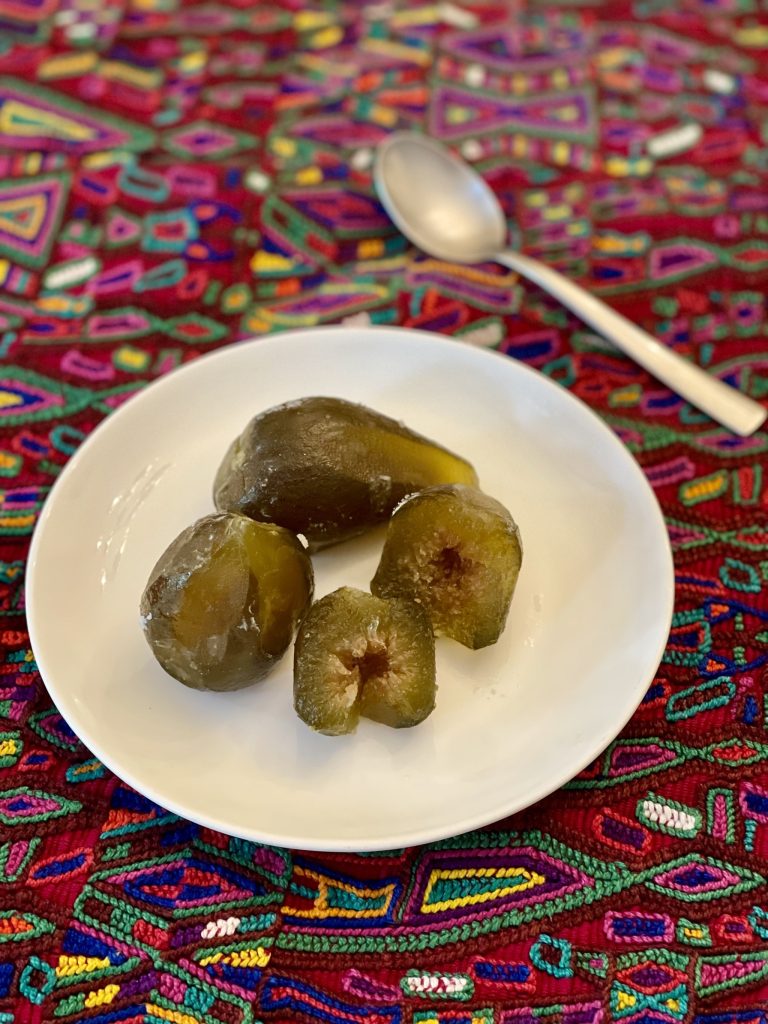
Interestingly, nixtamalization is not limited to grains. It is also a key step in preparing crystallized fruit candies, a traditional desserts. By applying this method to fruits, they undergo a transformation that locks in a sweet and distinct taste. Nixtamalization also helps the fruit maintain a firm consistency throughout the cooking process preventing it from falling apart.
Guatemalan Fig Candy Recipe: Higos en Maleta
Makes 24 figs
Ingredients
- 24 firm green figs (about 1 pound)
- 1/2 tablespoon slaked lime (food grade calcium hydroxide)
- 4 1/2 cups water
- 4 cups sugar
- 1 cinnamon stick
Instructions
- Cut a crisscross ¼ inch deep into the stem end of each fig.
- Peel the figs, but leave the stem intact.
- Dissolve the lime in 6 cups of the water, and add figs. Soak overnight.
- The next day drain the figs well and put them, the other 3 cups water, the sugar and cinnamon stick together in a large saucepan.
- Bring to a boil and reduce the heat immediately to a low simmer.
- Simmer slowly for 4 hours, or until all the liquid has evaporated.
- The pan should remain covered, or almost so, for the first 2 hours; then simmer uncovered during the last 2 hours.
- Remove the figs from the pan and air-dry them individually on a wooden tray for several hours or more.
Note: The slaked lime (food grade calcium hydroxide usually) is available in drugstores, stores selling preserving equipment or on Amazon here. It is used to firm the figs so they will not disintegrate in cooking and to preserve them. This is part of the nixtamalization process mentioned in the article.
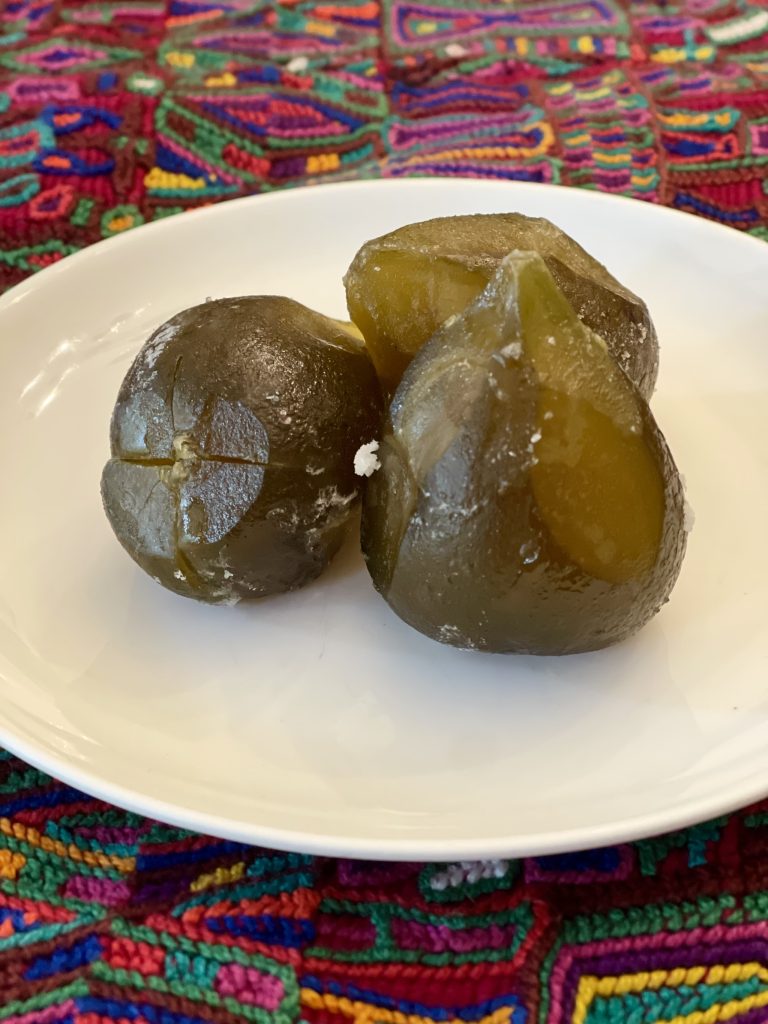
How to store this traditional fig candy, (higos cristalizados)
Once the figs are completely cooled and the sugar has hardened crystalized figs can be stored in an airtight container. There is no need to refrigerate them. There is also no need to freeze them as they will last a long time and freezing them will change their texture.
How long does Guatemalan fig candy last?
Cooking with lime alters the structure of the food and adds nutrients. In a way, the alkalization it provides changes the environment, making it a preservation method. That’s why this recipe was used to preserve fruits throughout the year. During the Spanish conquest, the recipes of the indigenous peoples were appropriated by the Spaniards and adapted to their taste. Fruits preserved in lime began to undergo a second cooking process in sugar and water with the introduction of cane sugar to this region. Gradually, the technique has been refined to achieve the shine we now see in crystallized fruit; the combination of techniques results in a crunchy texture on the outside and soft on the inside. Crystallized fruit is supposed to last up to 6 months and does not need to be refrigerated. However, it’s always good to be careful and make sure that this artisanal candy has maintained its consistency, color, flavor, and smell. At my house, higos en maleta or crystalized figs don’t last more than a couple of weeks, so I can’t vouch that they really last 6 months.
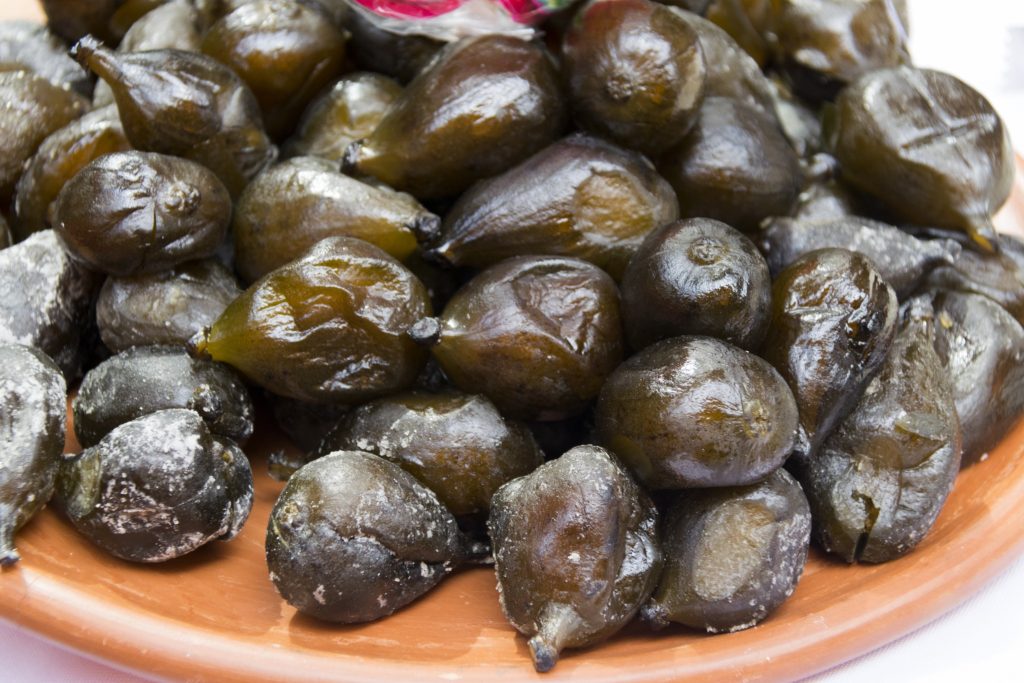
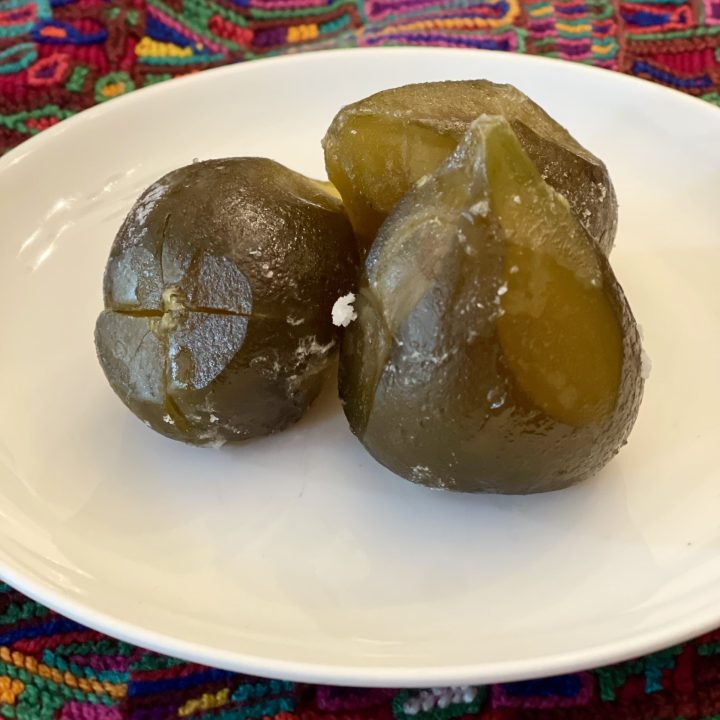
Guatemalan Fig Candy Recipe: Higos en Maleta
Ingredients
- 48 firm green figs (about 1 pound)
- 1 tablespoon slaked lime (food grade calcium hydroxide)
- 9 cups water
- 8 cups sugar
- 1 cinnamon stick
Instructions
- Cut a crisscross ¼ inch deep into the stem end of each fig.
- Peel the figs, but leave the stem intact.
Dissolve the lime in 6 cups of the water, and add figs. Soak overnight. - The next day drain the figs well and put them, the other 3 cups water, the sugar and cinnamon stick together in a large saucepan.
- Bring to a boil and reduce the heat immediately to a low simmer and cover.
- Simmer slowly for 2 hours, then uncover and simmer for an additional 2 hours or until all the liquid has evaporated.
- Remove the figs from the pan and air-dry them individually on a wooden tray for several hours or more.
Notes
The slaked lime (food grade calcium hydroxide usually) is available in drugstores, stores selling preserving equipment or on Amazon. It is used to firm the figs so they will not disintegrate in cooking and to preserve them. This is part of the nixtamalization process mentioned in the article.
Nutrition Information:
Yield: 48 Serving Size: 1Amount Per Serving: Calories: 166Total Fat: 0gSaturated Fat: 0gTrans Fat: 0gUnsaturated Fat: 0gCholesterol: 0mgSodium: 3mgCarbohydrates: 43gFiber: 1gSugar: 41gProtein: 0g
Other Guatemalan Desserts
Plátanos En Mole
Looking for a dessert that’s both sweet and savory? Look no further than Platano en Mole, a beloved Guatemalan food that’s sure to satisfy any craving! Featuring ripe plantains smothered in a rich, aromatic mole sauce, this dish is a true feast for the senses. Whether you’re a seasoned foodie or just looking to try something new, Platano en Mole is a must-try dessert that’s sure to leave a lasting impression!
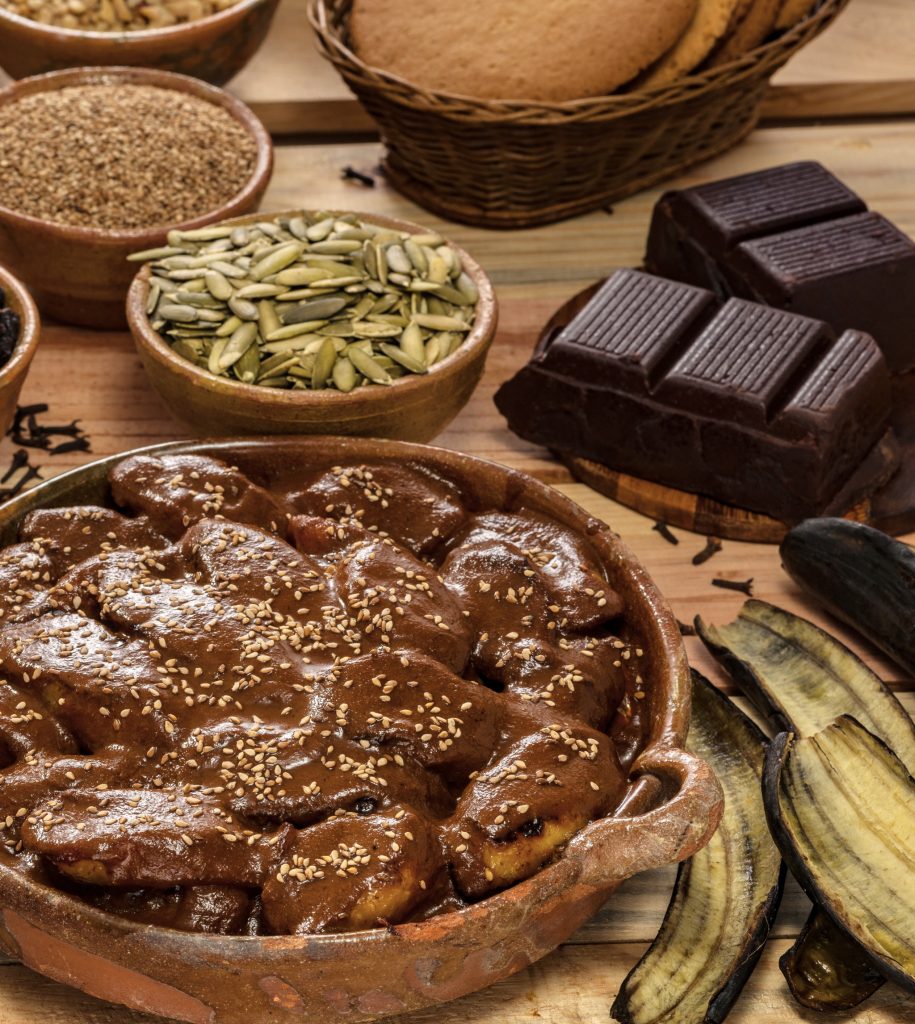
Empanadas De Manjar De Leche (Filled With Custard)
Empanadas de manjar are hand pie-like pastries filled with a milk-based creamy filling. If you want to surprise your loved ones with this delicious Guatemalan dessert, here is a quick recipe for you to prepare.
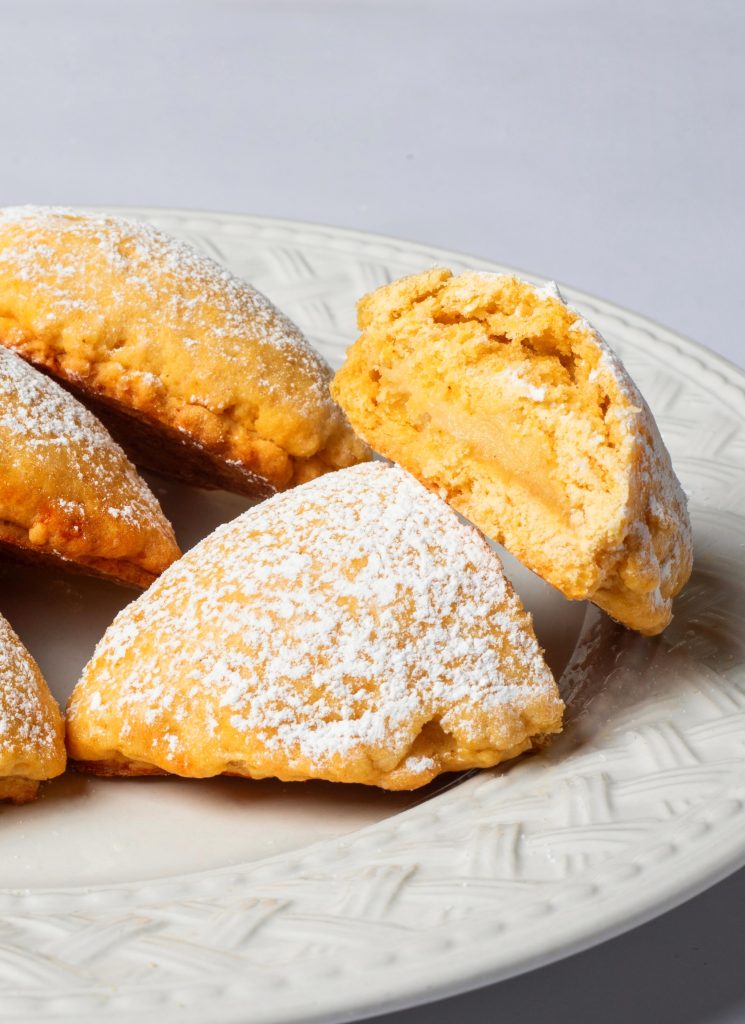
Cocadas Reales:
This delicious traditional Guatemalan coconut candy recipe is one of my favorite Guatemalan candy. Known as cocadas reales this coconut candy is made with shredded coconut and condensed milk on the stove top. Chewy, sweet and deliciously soft this traditional Guatemalan candy is a sweet treat that you’re sure to fall in love with.

Champurradas
A super easy recipe for champurradas that will surely be a success with everyone in the family! Guatemalan champurradas are scrumptious giant cookies with the perfect level of crunch to dunk in your morning coffee! This traditional Guatemalan dessert is so simple to make and perfect if you’re looking for an easy Guatemalan dish.
